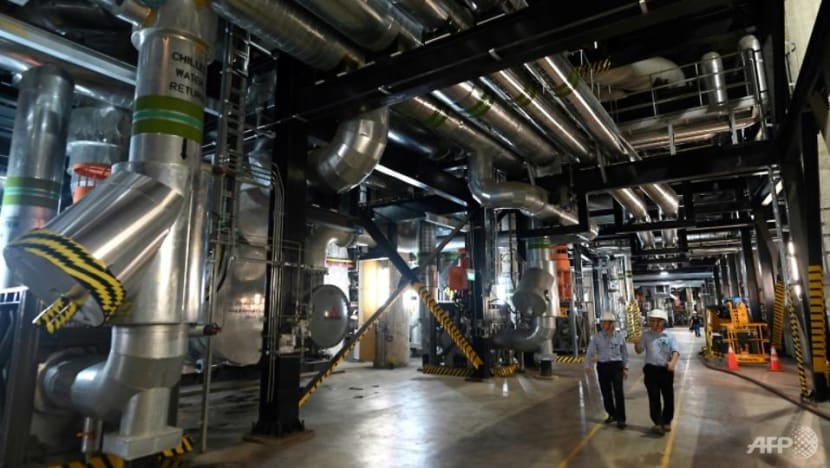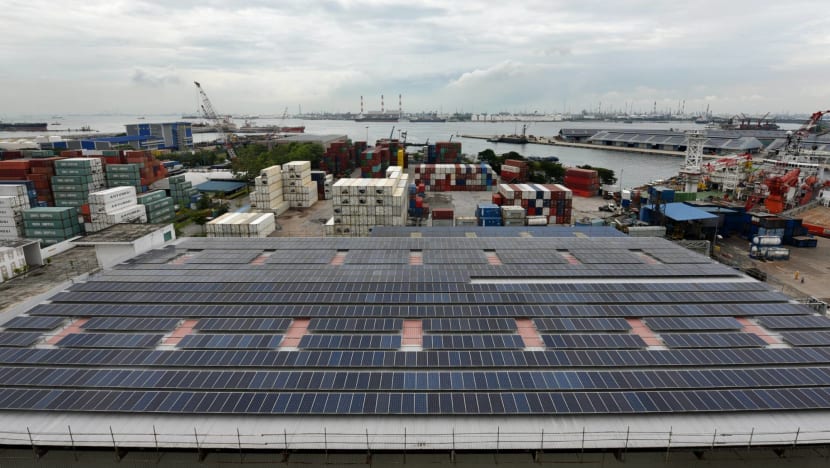commentary Commentary
Commentary: The world is hungry for green cooling solutions. Thankfully, Singapore is pioneering them
New climate-friendly technologies won’t just provide comfort for billions. They will make Singapore the pinnacle of sustainable prosperity, says James Trevelyan.

A youth cools himself off at a water fountain near Marina Bay in Singapore. (File photo: Reuters)
SINGAPORE: Climate change is often seen as a threat to human existence and the chief emitters of greenhouse gases the villains.
Take air conditioning, for instance, which enabled Singapore to become the thriving commercial and financial hub of Southeast Asia but contributes a significant proportion to carbon emissions.
Indeed, current air conditioning technology – which is now a century old – has massive environmental costs.
LISTEN: How hot can cities get and what can we do to cool things down?
If the 3 billion people living in the tropics followed Singapore’s path of development, air conditioning would cook the planet. A 2018 study by Rocky Mountain Institute predicts the number of air conditioners in emerging economies to increase fivefold by 2050, contributing over 0.5 degrees Celsius of global warming by 2100.
Yet recent commentary have singled out air conditioners unfairly. These couldn’t be further away from the truth when groundbreaking advances in this field have opened up new possibilities.
New climate-friendly technologies emerging here could not only provide comfort for billions, but could also help make Singapore the pinnacle of sustainable prosperity.
READ: Commentary: Air-conditioning – the unspoken energy guzzler in Singapore
READ: Commentary: We lived fine without air conditioning for a very long time
INNOVATIVE COOLING TECHNOLOGIES
The new School of Design and Environment at the National University of Singapore’s (NUS) Kent Ridge campus is a precursor of a cool, energy-efficient future for office buildings and factories in coastal humid climates.
The building has achieved almost net-zero energy consumption – the first of its kind in the tropics – with rooftop solar panels, a novel air conditioning system, and natural ventilation and lighting.
Ceiling fans provide comfort and fresh air with much less refrigeration cooling, leading to enormous energy savings – up to S$180,000 per year.

Such efforts have forged a path for bolder ideas for other net-zero energy buildings. Singapore Management University’s recently opened Connexion building, for instance, boasts its own photovoltaic system, passive cooling design, and smart building control systems.
Beyond cooling, dehumidifying could play a significant role in keeping us comfortable.
READ: NUS engineers invent hybrid air-conditioner that reduces electricity consumption
Engineers at NUS, for example, realised that a desiccant wheel and a vacuum (which sucks water out of air with tiny tubular fibres) can remove most of the oppressive humidity more efficiently than compressor refrigeration. Some of the water then cools the air by evaporation.
Practical solutions using these technologies are expected to emerge in the coming decade.
In the meantime, they realised that liquefied natural gas arrives at Singapore at a temperature of about -160 degrees Celsius. They will tap into this ”cold” energy by piping it to data centres using water containing phase change materials – substances that absorb heat when transitioning from solid to liquid state.
They think that cooling data centres will be the first killer application demonstrating the commercial potential of their research on new cooling technologies.
READ: Commentary: When our insatiable appetite for data can harm the environment too
READ: Commentary: All our Netflix binge-watching is costing the environment
Cooling technologies aren’t limited to refrigerating and dehumidifying the air either. Researchers from the University of California Berkeley demonstrated how radiant cooling panels could be deployed in Singapore to cool people even when they’re outdoors – for instance, at a bus stop.
These panels – chilled by cold water and designed to avoid condensation forming on their surfaces – keep people comfortable without cooling the air. When combined with desiccants for dehumidification, they could potentially lead to large energy savings.
Another out-of-the-box solution is the personal air conditioner, which has proven its effectiveness in some of the hottest parts of the world and is now also available in Singapore. It provides cooling for people without having to cool entire spaces or buildings.
Like a tiny fridge with a fan inside, it generates a gentle breeze that cools people nearby using as little as 300 Watts – far less than conventional room air conditioners, which use 900 to 2,400 Watts.

All these energy saving ideas can help quell the urban heat-island effect that has raised Singapore’s night-time temperatures by up to 7 degrees Celsius, due in part to warm air belched out from energy-hungry air conditioners and gasoline engines in cars.
SOLAR TO POWER GREEN COOLING
In the long-term, these ideas can also help Singapore meet its targets to halve peak carbon emissions by 2050, and to reach net-zero emissions thereafter.
By then, energy-efficient technologies will displace older air conditioning technologies. Natural, environment-friendly refrigerants will replace today’s hydrofluorocarbons. And renewable solar and wind electricity will supplant the use of fossil-fuelled electric power generators.
Electric vehicles and other innovations could help Singapore decrease its greenhouse emissions to near-zero.
READ: Commentary: What will it take to make Singapore truly car-lite?
Plentiful, cheap solar electricity is already providing most day-time electricity generation in some countries. Australia has one of the highest penetration rates of rooftop and large-scale solar systems worldwide. Daytime electricity prices have plummeted and are sometimes negative.
However, night-time power could be a different challenge altogether, turning energy-management techniques upside down. For decades, savvy individuals and businesses have exploited cheap off-peak power at night from fossil-fuelled power stations that run best with a steady load.
In the solar, climate-constrained future, night-time power will mostly come from costly battery storage or fossil-fuelled generators with carbon-capture and storage. The latest estimates indicate a wholesale price around S$0.35 cents a unit.
The meter price will be even higher, accelerating consumer demand for energy-efficient air conditioning technologies.
READ: Commentary: Singapore’s dreams of becoming a solar-powered nation have almost arrived

Thermal batteries could be a cheaper option than the better known electrical batteries for air conditioning systems. These can be as simple as large tanks that store water chilled with cheap daytime solar electricity. The chilled water can be used later to provide cooling through the night.
Phase change materials can also be used to boost the thermal capacity of the water, in effect enabling more cooling energy to be stored in the same volume of water.
EMERGING MARKETS RIPE FOR COOLING SOLUTIONS
The real action will be in Asian economies with huge urban populations: China, Indonesia, India, Bangladesh and Pakistan.
Only a tiny minority today can afford routine use of conventional energy-guzzling air cons. People living in poorly insulated high-rise buildings will be increasingly desperate for cooling as the climate warms.
LISTEN: Getting to the heart of energy and climate change
READ: Commentary: When Singapore homes become workspaces – huge changes in the house and beyond
The US$3 million (S$4.1 million) Global Cooling Prize will soon announce which of eight innovations has won the quest for a split air conditioner replacement with five-times less climate impact. Nevertheless, the organisers accept that these machines could be twice as expensive or more compared with today’s models.
Some of the energy-efficient innovations emerging in Singapore today could be the answer so many people have been searching for. Positioned at the doorstep of the world’s fastest-growing economies with nearby air conditioner manufacturing centres in Malaysia, Thailand and Indonesia, the opportunities for Singaporean innovators and entrepreneurs are plenty.
I am confident that in the not-too-distant future we will see cheap and energy-efficient air conditioning across the region accessible to all, running mostly on renewable electricity.
We will remember today’s climate emergency forecasts and wonder why we did not seize this golden opportunity earlier.
James Trevelyan is CEO and Founder of Close Comfort, a cooling solutions company based in Singapore and Australia.














